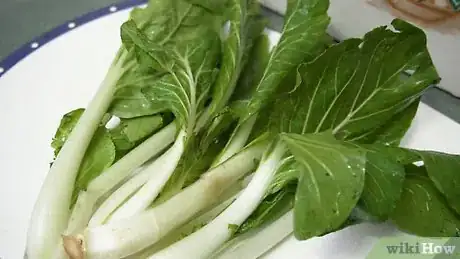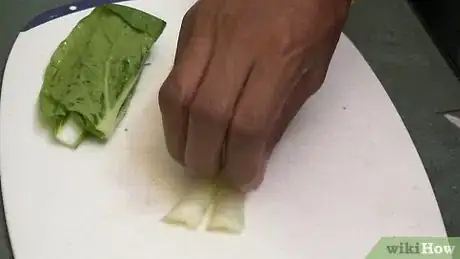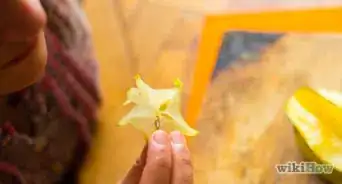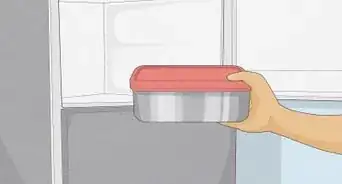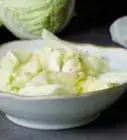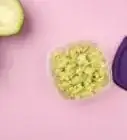This article was co-authored by wikiHow Staff. Our trained team of editors and researchers validate articles for accuracy and comprehensiveness. wikiHow's Content Management Team carefully monitors the work from our editorial staff to ensure that each article is backed by trusted research and meets our high quality standards.
There are 14 references cited in this article, which can be found at the bottom of the page.
The wikiHow Video Team also followed the article's instructions and verified that they work.
This article has been viewed 453,145 times.
Learn more...
A bright green member of the cabbage family, bok choy is a crunchy, fresh and mild-tasting addition to a meal. Packed with nutritious vitamins, great texture and subtle flavor, bok choy is found in many Asian recipes, but this versatile vegetable can be used in salads, soups, stir-fries and more. Both the leaves and the stalks can be eaten.
Steps
Choosing and Washing Your Bok Choy
-
1Choose bok choy with bright green leaves and crisp stalks. Look for heads with bright green leaves — not yellow or brown — and crisp white stalks without holes or discoloration. Avoid any bok choy bunches that look rubbery or dried out towards the stem. Crunchy is good![1]
- Bok choy, also known as pak choi, can be found in a number of varieties that offer different flavors, sizes and colors.
- Varieties with larger leaves tend to work well for salads and soups, while the smaller, narrower heads work well for stir-fries.[2]
-
2Buy baby bok choy for a milder flavor. Baby bok choy is a smaller variety of bok choy that is just harvested earlier than mature bok choy. The stems are usually thicker and the leaves are smaller. The flavor is usually pretty similar to regular bok choy, but it often milder and more tender.[3]
- Baby bok choy is also appealing because you can cook the vegetable whole without needing to break the leaves apart.[4]
Advertisement -
3Store your bok choy in a plastic bag in the fridge for up to 5 days. Place your bok choy in a grocery store plastic produce bag. With the bok choy in the bag, run your hand along the stalk to push the air out of the bag. Twist the end of the bag so it stays shut and store it in your produce drawer in your refrigerator for up to 5 days.[5]
-
4Trim and discard the thick base of the bok choy stem. Use a sharp knife to slice off the bottom 1⁄2 to 1 inch (1.3 to 2.5 cm) just above where the base of the leaves connect. Pull off and discard any outside leaves that are discolored or particularly tough. You will be left with several long individual bok choy stalks.
-
5Wash the individual bok choy stalks in a bowl of cold water. Separate the leaves and swish them around in large bowl full of cold water. Gently rub the leaves together to remove any dirt. Drain the water from the bok choy using a colander.
Slicing the Bok Choy
-
1Bunch the stalks together and slice off the white stems. Once all the stalks have been washed, lie them flat on your cutting board. Then, group them together in a bunch and use your knife to separate the thick, white stems from the green leaves.
- Keeping the stems and leaves separate is helpful because the stems and the leaves tend to cook at different rates, with the stems cooking slower than the leaves.[8]
-
2Hold the bok choy in a stable position using a claw-like grip. Grip the bok choy with your fingertips and curl them inwards, pressing only the knuckles of your middle and ring fingers against the knife blade. This grip will protect your fingers.[9]
-
3Hold your knife at a 45 degree angle over the bok choy stems. Don’t chop the stems by bringing the knife straight down — hold it at a 45 degree angle for a slanted cut across the stem. Slicing at an angle like this works to increase the surface area of each piece, allowing the bok choy to cook faster.
-
4Slice the bok choy into 1 in (2.5 cm) sections. Cut the stems into 1 in (2.5 cm) sections beginning at the base and slicing all the way up to the top. Gradually move the hand that holds the bok choy away from the knife as you slice further along the stalk. Then, repeat this process for the leaves.
- Make your cuts thinner if you’re looking to make a stir fry.
Cutting the Bok Choy Into Rectangles
-
1Cut an individual stalk in half down the middle. Make a long cut down the middle of an individual white stalk to separate it into 2 halves. Lay these halves next to each other flat on your cutting board.[10]
- If you want thinner rectangle slices, cut your bok choy stalk into thirds.
- Rectangle cuts can be great if you’re looking to saute bok choy stems with other vegetables or meats.
-
2Separate the green leaves from the white stem. Slice off the leafy part of the bok choy, leaving mostly thick, white stem. It’s fine if you leave some of the smaller leaf sections where the leaves connect to the stem, but try to remove as much of the leaves as you can.
-
3Cut the stem into 1 in (2.5 cm) long rectangular pieces. Make horizontal cuts to divide the stem up into bits that are roughly the shape of rectangles. These pieces should be pretty thick.[11]
Dicing the Bok Choy
-
1Cut the leaves off of the bok choy. Take an individual stalk of bok choy and cut off the top leafy part. You should be left with the remaining white stem.[12]
- Diced bok choy is a wonderful addition to soups and salads!
-
2Slice the stem vertically into 3 long strips. Use a larger knife to make these longer cuts in 1 smooth motion each. Try to make all the strips about the same width.[13]
-
3Cut the strips horizontally into small 1⁄2 in (1.3 cm) long diced pieces. Bunch the strips together with your non-dominant hand, and carefully dice them into small pieces starting at the end of the stem. 1⁄2 in (1.3 cm) long is good, but make the pieces smaller if you want.[14]
Community Q&A
-
QuestionCan I eat raw bok choy?
 Community AnswerYes you can.
Community AnswerYes you can. -
QuestionWhat is wrong if my bok choy plants have tiny holes in the leaves?
 Community AnswerIt's probably bug damage. It's not a big deal, just make sure you wash and check for bugs before consuming. If you're very concerned or have especially buggy vegetables, you can soak them in salt/vinegar water or get a special soap meant for washing vegetables.
Community AnswerIt's probably bug damage. It's not a big deal, just make sure you wash and check for bugs before consuming. If you're very concerned or have especially buggy vegetables, you can soak them in salt/vinegar water or get a special soap meant for washing vegetables. -
QuestionHow long will bok choy last?
 Community AnswerBok choy will only last for three to five days in the fridge, even when it is stored properly.
Community AnswerBok choy will only last for three to five days in the fridge, even when it is stored properly.
Warnings
- Make slow, deliberate slices until you get more comfortable slicing at a faster pace.⧼thumbs_response⧽
- Use a well-sharpened chef’s knife to cut the bok choy as dull knives are more likely to slip and cause injury.⧼thumbs_response⧽
Things You’ll Need
- Cutting Board
- Sharp Knife
- Colander or Strainer
- Large Kitchen Bowl
References
- ↑ https://www.youtube.com/watch?v=N6u38pf6r6s&feature=youtu.be&t=1m13s
- ↑ https://experiencelife.com/article/bok-choy/
- ↑ https://www.youtube.com/watch?v=N6u38pf6r6s&feature=youtu.be&t=35s
- ↑ https://www.epicurious.com/archive/seasonalcooking/farmtotable/visualguidecookinggreens
- ↑ https://www.youtube.com/watch?v=N6u38pf6r6s&feature=youtu.be&t=1m28s
- ↑ https://www.youtube.com/watch?v=N6u38pf6r6s&feature=youtu.be&t=1m58s
- ↑ https://www.foodroots.co/blog-2/2019/2/27/a-bok-choy-how-to
- ↑ https://www.youtube.com/watch?v=N6u38pf6r6s&feature=youtu.be&t=2m4s
- ↑ https://www.seriouseats.com/2010/05/knife-skills-how-to-hold-a-knife.html
- ↑ https://www.youtube.com/watch?v=JpFHsHpCUPw&feature=youtu.be&t=57s
- ↑ https://www.youtube.com/watch?v=JpFHsHpCUPw&feature=youtu.be&t=1m3s
- ↑ https://youtu.be/JpFHsHpCUPw?t=1m18s
- ↑ https://www.youtube.com/watch?v=JpFHsHpCUPw&feature=youtu.be&t=1m21s
- ↑ https://www.youtube.com/watch?v=JpFHsHpCUPw&feature=youtu.be&t=1m25s
About This Article
To cut bok choy, use a sharp knife to trim and discard the bottom 1/2 to 1 inch of the stem, and pull off and discard any discolored or tough leaves on the outside of the bunch. Gather all of the stalks together and slice off the thick, white stems from the green leaves. This is helpful because the stems will cook at a different speed than the leaves. Hold the knife at a 45° angle over the bok choy and slice the stems and leaves into 1-inch sections. If you want to cut your bok choy into rectangles, keep reading!
